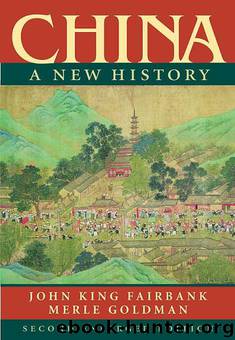China: A New History (Second Enlarged Edition) by John King Fairbank && Merle Goldman

Author:John King Fairbank && Merle Goldman
Language: eng
Format: mobi
15
The Second Coming of the Chinese Communist Party
Problems of Life on the Land Among the origins of a revolutionary movement, the popular mentality among illiterate farmers is least easy to perceive, whereas material livelihood can be seen in economic conditions and, with luck, statistics. China’s economic growth during the Republican era from 1912 down to Japan’s attack in 1937 is still being debated. One optimistic view—based largely on overall statistics of production, trade, and investment—cites impressive figures such as China’s great increase in the production and consumption of cotton textiles, which in the mid-1930s used more cotton than Britain and Germany combined. Thomas Rawski has marshalled statistics of growth in banking services, money supply, wage rates, transportation and shipping, consumption, and the like, which all go along with continued population growth. He pictures a society that is steadily industrializing. Yet in so big a country this overall landscape may have included large urban slums and numberless impoverished villages.
About China’s rural poverty there have been two schools of thought. One school has stressed the exploitation of the farmer by the ruling class through rents, usury, and other exactions, resulting in a maldistribution of income. This idea of landlord-class exploitation fitted Marxist theory and became with many people an article of faith. The other school, as Ramon Myers (1970) points out, has been more “eclectic”; it has stressed the many reasons for the low productivity of the old farm economy: farms of two acres per family were too small; even these tiny plots were improperly used; peasants had insufficient capital and limited access to new technology; there was little control over nature; primitive
294 transport increased marketing costs. Supporters of this interpretation point to the fact that most Chinese farmers owned their land, some were partly owners and partly tenants, and only about one quarter or one fifth were outright tenants, so that landlord exploitation of tenants was far from the general rule and less of a problem than the general lack of capital and technology compared with the abundant supply of labor. The labor supply was assured by the social imperative to beget children who could care for their parents in old age. This care included the presence of a son to carry on the family line and specifically to offer the ritual sacrifices at the family altar that would prevent the spirits of departed parents from roaming about as homeless ghosts.
Whether one stresses inefficiency of production or maldistribution of the product, it remains apparent that village social structure was all-important at the rice-roots level. Subcounty administration, a comparatively neglected area, has been analyzed by Prasenjit Duara (1988) among others. He begins with the fact that “under the late Qing reforms the village was required to develop a fiscal system to finance modern schools, administrative units, and defense organizations.” This unprecedented penetration of the state into the rural society was marked by the levy of new taxes not on individuals or on private property as before but on the village as a new fiscal entity.
Download
This site does not store any files on its server. We only index and link to content provided by other sites. Please contact the content providers to delete copyright contents if any and email us, we'll remove relevant links or contents immediately.
| Central Asia | Southeast Asia |
| China | Hong Kong |
| India | Japan |
| Korea | Pakistan |
| Philippines | Russia |
The Sympathizer by Viet Thanh Nguyen(4308)
The Rape of Nanking by Iris Chang(4140)
World without end by Ken Follett(3432)
Ants Among Elephants by Sujatha Gidla(3417)
Blood and Sand by Alex Von Tunzelmann(3140)
Japanese Design by Patricia J. Graham(3112)
City of Djinns: a year in Delhi by William Dalrymple(2516)
The Queen of Nothing by Holly Black(2499)
Foreign Devils on the Silk Road: The Search for the Lost Treasures of Central Asia by Peter Hopkirk(2435)
India's Ancient Past by R.S. Sharma(2417)
Inglorious Empire by Shashi Tharoor(2396)
Tokyo by Rob Goss(2390)
In Order to Live: A North Korean Girl's Journey to Freedom by Yeonmi Park(2348)
India's biggest cover-up by Dhar Anuj(2319)
Tokyo Geek's Guide: Manga, Anime, Gaming, Cosplay, Toys, Idols & More - The Ultimate Guide to Japan's Otaku Culture by Simone Gianni(2316)
The Great Game: On Secret Service in High Asia by Peter Hopkirk(2305)
Goodbye Madame Butterfly(2209)
Batik by Rudolf Smend(2128)
Living Silence in Burma by Christina Fink(2038)
